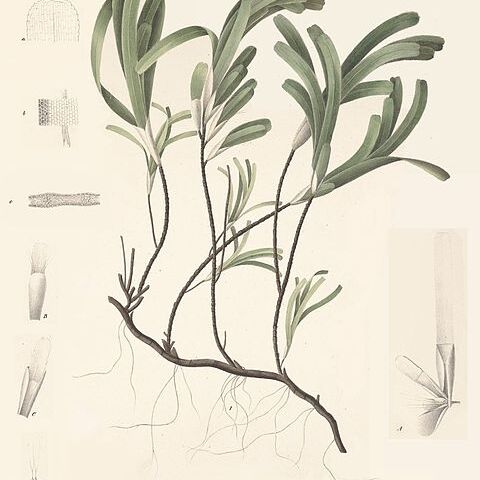Perennial, woody, rhizomatous herbs, glandular-punctate. Roots 6 (occasionally some bifurcating) appearing in a circle from definite points on the fourth node and inter-node of each section of the sympodial rhizome, long, much-branched, forming dense mats, woody, with long scattered root-hairs their thickened bases persisting as short bristles. Rhizome sympodial, each section consisting of 4 internodes, the fourth forming the erect stem, a lower bud continuing the rhizome; internodes angled, smooth, orange brown, with deltoid, amplexicaul, early deciduous bracts. Stems erect, up to 50 cm, unbranched, or rarely with a short side branch, with prominent annular, curved leaf-scars, the lowest internodes up to 15 mm long, the upper brown, occasionally forming a few rootlets below. Leaves about 6-10, in distichous apical tufts, early deciduous, strap-shaped, falcate, 7-15 cm long and 7-15 mm broad, leathery, margin with erect teeth in upper half and on the obtuse to truncate apex, midrib distinct and with about 10 lateral nerves on each side; below the lamina is attached to a light brown, punctate, flat, stipular sheath which is tapered to the base, with folded margins and a narrow rim-like ligule above; axillary scales setaceous, 3-6. Flowers on much abbreviated side branches near the base of the leaf-clusters; the leaves also reduced in size to form bracts. Male flowers consisting of 2 fused stamens with the 2 pairs of apiculate locules facing opposite directions; filaments (or pedicels)presumably lengthening rapidly during anthesis and soon disintegrating, pollen filamentous. Female flowers at first sessile, peduncle accrescent, knobbed, 4-14 mm long, flattened, erect, adjacent to the main stem with 2 fertile pairs of bracts, the inner of a pair about1/3 of the outer in size; the 2 collateral carpels situated on the apex of the peduncle, surrounded by groups of setae (axillary scales), carpels ovoid, compressed lengthwise with a short style 4 mm long divided into 2 subulate stigmatic arms about 25 mm long, ovule solitary, pendulous. Fruit (immature?) cylindrical, about 15 mm long, 2 mm broad, apex truncate.
Gregarious marine herb; rhizome mat-forming, robust, to 5 mm thick, internodes 0.5– 3 cm long.. Stems erect, unbranched or little-branched, orange-brown, 10– 65 cm long; second stem usually only present as a bud.. Lower leaves often at right angles to the stem, those above ascending, leaf with sheath cream to pink, 1.5– 3 cm long, auriculae obtuse, ligule obtuse, 2– 2.5 mm long and 10 mm wide, scars closed; blade linear, falcate, 7– 15 cm long, 6– 13 mm wide, base narrowed, margin entire except near apex, apex rounded, often ± emarginate, denticulate, the teeth to 1 mm long, sometimes 2– 3-furcate, green, drying brown; nerves 17– 27, connected by oblique cross-veins.. Staminate flower subsessile, surrounded by 4 bracts, the outer and inner smallest, the middle two with sheath and small blade, anthers linear, 6– 7 mm long, yellow tinged with red.. Pistillate flower with bracts similar to those of staminate, but inner bract fleshy, ovary ellipsoid, 2 mm long, style 4 mm long, stigmas 20 mm long.. Fruit ellipsoid, 3.5– 5 cm long, of 2 carpels surrounded by the enlarged inner bract.. Fig. 1.
Submerged, sometimes intertidal herbs. Rhizome to 5 mm diam.; internode 1.5–3 cm long; scales 6 mm long. Roots 1–5, strong, much-branched, coiled, 0.5–2 mm diam., with light brown surface. Leaf sheath 15–30 mm long; ligule obtuse, 2–2.5 mm high, 10 mm wide; auricles obtuse. Leaf blade 10–15 cm long, 6–12 mm wide, slightly narrowed at base; margins almost entire except with irregular serrate teeth near tip; apex truncate, often emarginate, denticulate with acute, sometimes bi-or trifurcate teeth; longitudinal veins 17–27. Inflorescence enclosed by 4 leafy bracts. Male flower subsessile; anthers 8–10 mm long. Female flower: ovary ellipsoid, 2 mm long; style 4 mm long; stigmas 20 mm long. Viviparous seedling to 8 cm long, with 5–8 seedling leaves; bract 4.5 cm long, 10–15 mm wide.


